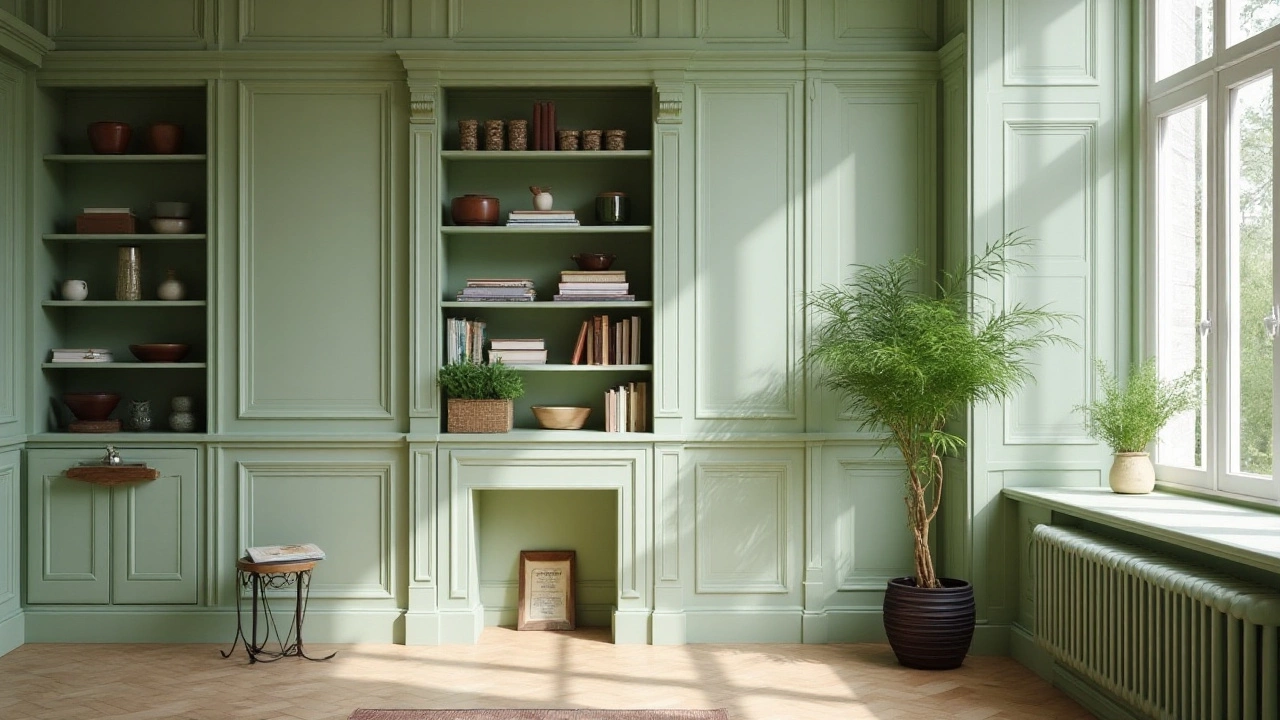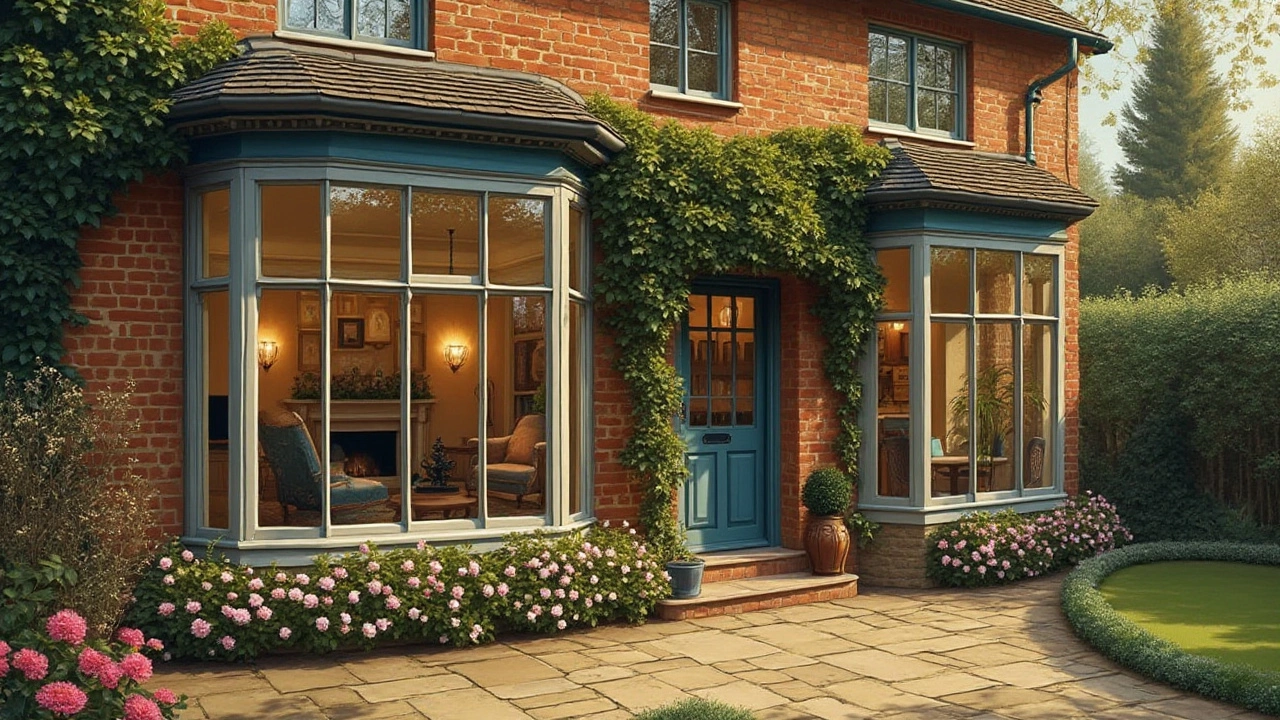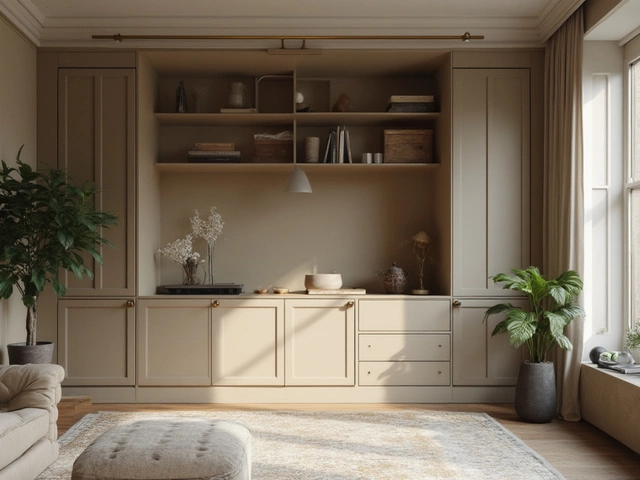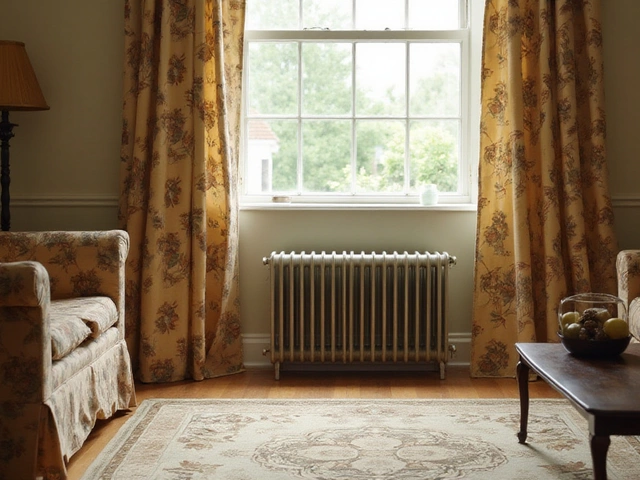Step into an old house, and you're often greeted not by walk-in closets but by charming nooks, steep staircases, and rooms with unique profiles. This absence of closets isn't just a curious quirk; it speaks volumes about social history and the evolution of daily life. Most vintage homes were designed during times when the average person had fewer belongings, and the concept of sprawling storage spaces hadn't yet taken hold. Instead, these homes focused on communal living areas for work and socializing.
As society evolved, so did our need for structured storage. Yet, for owners and lovers of old homes, this lack of closets presents an opportunity for creativity. It calls for ingenious solutions to protect and organize modern-day possessions while retaining the historical integrity of the home. Whether you're living in an old treasure or considering one, knowing how to maximize every inch for storage can blend the charms of the past with the conveniences of today.
- Historical Context
- Lifestyle Changes Over Time
- Impact on Modern Living
- Creative Storage Solutions
- Balancing Originality and Functionality
- Tips for Homeowning in Old Houses
Historical Context
In the world of architecture, particularly in homes constructed before the 1900s, closets simply weren’t a priority for builders or homeowners. This absence is largely attributed to the way people lived and what they valued during those times. The average household in the late 19th century and earlier did not require extensive storage solutions, partly because they possessed significantly fewer belongings compared to the contemporary families of today. Most clothes and personal items were often housed in large, freestanding pieces of furniture like wardrobes or armoires, which were not only functional but also served as statements of style and wealth.
Beyond mere practicality, societal norms dictated the size of one's wardrobe, limiting the number of outfits people owned, which considerably reduced the need for built-in storage. According to the U.S. Bureau of Labor Statistics in 1900, the average American worker earned fewer than $442 annually, making it clear that purchasing excess clothing was simply not an option. The concept of 'Sunday best' emerged, which referred to that single set of clothes reserved for church and special occasions, leading to minimal wardrobe requirements for daily life.
Old houses reflect the communal and multi-generational living structures of the past. Centralized heating wasn't widespread, meaning families often gathered in fewer, cozier rooms during colder months, further emphasizing the need for open, adaptable spaces rather than designated storage areas. An often encountered feature in older homes is the presence of large windows and ornate fireplaces, which were often more critical to the architectural integrity of a home than storage. This reflects the era's appreciation for aesthetic elements that impressed guests, who visited frequently as social life was centered on home-based gatherings.
Architectural historian Jane Smith once mentioned, “The design of early homes prioritized spaces for community and warmth, reflecting the core of the family unit during that era.”As a result, attention was directed towards creating inviting living areas that facilitated interaction rather than on areas designated for storing personal effects. This historical approach to homebuilding left modern occupants of such homes to devise their own storage solutions, turning the lack of closets into an opportunity for creative storage methods.
In light of changing times and styles, the migration pattern to urban areas during the Industrial Revolution marked a shift. Housing in cities needed to be effective and compact, leading to the birth of row houses and apartments. However, even these urban homes shared common traits with suburban houses; both types were typically void of such storage solutions as we would expect today. This historical context reveals that, while the closet-free home might seem outdated, it stemmed from a deeply pragmatic and socially-driven design ethos that prioritized communal living and aesthetic mobility over extensive personal storage space.
Lifestyle Changes Over Time
In the tapestry of architectural history, the absence of closets in old houses is intertwined deeply with the society and lifestyle choices of bygone eras. In the days when such homes were constructed, households were simpler—with fewer clothes, accessories, and personal items when compared to today's standards. Most people owned only a few outfits—often one for everyday wear, another for Sunday best, and perhaps a handful for special occasions. Thus, the need for extensive, designated storage areas simply didn't exist as it does now.
The Victorian era, for example, focused heavily on entertaining and demonstrating wealth through tastefully decorated salons and parlors rather than closet space. Often, clothes were stored in chests or armoires, reflecting a period where the portability of belongings mattered more than built-in storage. The domestic architecture was a testament to creating public spaces for gatherings, essentially relegating the bedroom as a private, and somewhat, unadorned personal zone.
As we moved into the 20th century, the rise of consumer culture dramatically shifted this balance. The post-World War II economic boom, along with the widespread industrialization and mass production of goods, brought an array of choices to the average household, from affordable fashion to decorative items. This shift was synchronized with a societal shift towards valuing personal space and the notion of the 'American Dream'—a larger home with ample storage. Bedrooms became more personalized, catering to the growing demand for individual expression through clothing and possessions.
The shift is both cultural and technological. Laundry appliances, as an example, meant people could keep more clothes clean efficiently and quickly, contributing to larger wardrobes. To illustrate, a
report from the Smithsonian Magazine highlights how "the average American household today keeps approximately 300,000 items," showcasing a stark contrast from earlier centuries.
In tandem with overflowing wardrobes, other lifestyle facets also called for additional storage. The rise of hobbyism, as people delved into leisure pursuits, demanded room for sports gear, crafting materials, and musical instruments. The face of family living evolved too, taking into account children's toys, books, and gadgets, further pushing the demand for expansive in-home storage solutions.
Of course, modern living's clutter extends beyond material possessions. As digital capabilities merge into the domestic sphere, homes now house interface devices, connectivity routers, and home office setups. Thus, while old houses charm us with their historical quaintness, adapting them to meet contemporary storage needs without compromising their aesthetic can be both challenging and rewarding. Understanding historical lifestyle shifts not only gives us a perspective on why spaces were designed a certain way but also equips us with the insight needed to work effectively within them.
Impact on Modern Living
Old houses may evoke feelings of nostalgia and charm, yet their lack of closets brings distinct challenges for today's homeowners. In contemporary society, where consumerism has skyrocketed, our possessions can be a testament to personal identity, style, and hobbies. This increase in material goods has heightened the need for adequate storage space, and many find the minimalist storage options of old homes to be mismatched with modern needs. The rising trend of working from home has also intensified the demand for functional spaces, making efficient storage solutions crucial. People often find themselves in a bind as they juggle preserving the historical essence of their homes while ensuring they can live comfortably and organized.
Adding to the complexity, innovative designs and furniture have come to the forefront, allowing for smart storage solutions without altering the home's original structure. Storage solutions that double as decor elements or that can be tucked away under stairs or within alcoves have become popular choices. Part of the appeal is that they offer practical benefits while maintaining the home’s vintage charm. As homeowners creatively redesign spaces, they often incorporate open shelves, wall-mounted hangers, or multipurpose furniture to balance aesthetics with functionality. This skillful adaptation reflects an embrace of both contemporary needs and historical charm.
For many, the decision to live in a historical home involves a complex calculus of aesthetics and logistics. According to a comprehensive study by Realtor Magazine, nearly 60% of buyers actively seeking older homes classify storage solutions as a top priority in their renovation plans.
"Owning an old house is like living with a piece of history. The essence is preserved while adapting it for today’s lifestyle can be rewarding," says Karen Hastings, a noted interior designer specializing in historical properties.It is evident from this trend that while old homes offer unparalleled character and charm, integrating modern living conveniences is an ongoing challenge that requires innovative thinking and planning.
As communities grow more aware of sustainable practices, many homeowners of older houses choose to repurpose and reuse existing materials. Instead of extensive renovations that could compromise the house's vintage integrity, they opt for eco-friendly storage solutions that make use of reclaimed wood or metal. This approach not only respects the original architectural design but also contributes to environmental sustainability. By striking a balance between past and present, these efforts showcase a respectful way to enjoy the best of both worlds.

Creative Storage Solutions
Living in an old house can be a delightful journey through history, but it demands a touch of creativity when it comes to storage. Embracing the ingenuity of using available space efficiently not only maintains the charm but also enhances functionality. One of the most historically resonant yet practical solutions is the use of freestanding furniture—think armoires and chests. These pieces, quite common in pre-closet eras, serve dual purposes today, offering both a nod to vintage aesthetics and robust storage options. Installing these pieces in a bedroom or foyer can instantly free up floor space. Interestingly, many of these classic items come with hidden compartments—originally designed for safekeeping valuables—which can now store small items that might otherwise create clutter.
For those who lean towards built-in solutions, converting unused space under staircases or employing shallow alcoves as storage nooks adds a bespoke touch. Custom cabinetry or shelving units in these tricky areas can disguise a wealth of storage, from books to seasonal clothes. Open shelves create an opportunity to showcase decorative items, merging practicality with personal expression. A significant advantage of shelving is it can be adjusted or re-purposed over time based on shifting needs. In doing so, not only is space maximized, but each piece integrates seamlessly into the house's architecture.
Vertical Solutions
Going vertical often liberates surprising amounts of space. By adding hooks or pegboards, often used in kitchen settings, you can manage utensils or coats efficiently. Pegboards offer both flexibility and ease of customization, adapting to different items and room setups effortlessly. A 2023 survey by the National Association of Professional Organizers found that vertical storage solutions can increase usable space by up to 30% in homes lacking traditional storage facilities. High cabinets or shelves are another avenue, ideal for infrequently used items, crafted in a style complementary to the home’s era.Innovative Repurposing
Repurposing vintage furniture into new storage marvels is another ingenious method. Turning a ladder into a towel rack or utilizing antique crates as under-bed storage are imaginative alterations that imbue a sense of continuity and resourcefulness. These solutions not only amplify your storage options but also respect the timeless lines of older architecture. According to interior designer Sophie Stewart, "The charm of old houses is in their distinction, and by repurposing pieces, we're continuing their story in a modern context."Another plentiful idea is the utilization of multi-functional furniture—ottomans with storage, beds with drawers, or table surfaces doubling as desks. These items marry simplicity with necessity, cutting down on clutter without encroaching on living areas. Additionally, keeping an eye on symmetry and proportionality ensures these furniture additions enhance rather than overwhelm your spaces.
Create spatial harmony with the local environment by selectively retaining and showcasing fewer items, thereby purging unneeded clutter. Practical storage solutions enable a harmonious blending of old and new, ensuring every treasured possession has its place without infringing on the quaint elegance of yesteryear homes. As needs and styles evolve, so too should your approach to keeping an old home functional, free of chaos, and full of elegance.
Balancing Originality and Functionality
When you find yourself drawn to the allure of an old house, it often comes with a deep appreciation for its history and craftsmanship. However, living without the modern convenience of closets poses quite the conundrum for contemporary homeowners. The key to maintaining the historical essence while giving it a practical update is to find that perfect equilibrium between preserving the past and embracing the present. This challenge can be overwhelming, but it is also an exciting opportunity to instill personal style through thoughtfully curated spaces.
Historically, these homes were built with rich, sturdy materials and featured unique architecture that demands respect. To incorporate modern storage solutions without stripping away these elements, consider freestanding furniture, which adds functionality without permanent alterations. Antique armoires, vintage chests, or modern pieces designed to echo traditional aesthetics can introduce a touch of elegance. They serve the dual purpose of storage and decoration, weaving seamlessly into the historic narrative of your space.
One of the cherished aspects of older homes is their intricate craftsmanship, evident in every corner of the house. To complement this, imagine building custom cabinetry that mirrors the style of woodwork from the era of your home. Not everything needs to be hidden; open shelving can be both practical and aesthetically pleasing. Consider using beautiful wooden or metal brackets that complement your home’s era to add shelving in overlooked areas, like under staircases or high in hallways.
Creative Design Considerations
Incorporating contemporary home organization solutions means being creative with hidden storage. Underutilized spaces can be transformed into efficient storage areas. Think about the attic or the basement—not just for storing holiday decorations but for everyday use, perhaps by converting them into custom closet spaces. Even simple additions like stylish hooks or hanging rods in unexpected places can add significant utility to a room.
Consider the benefit of dual-purpose furniture, which is an essential piece of the puzzle for space maximization in old homes. Ottomans that open to store blankets or coffee tables with hidden compartments can free up areas you might have never imagined. Moreover, by tearing down or opening up non-load-bearing walls to create larger rooms with built-in storage or an extended reach-in closet, you preserve the charm while satisfying modern needs.
"The challenge with old houses is using the space effectively while respecting the craftsmanship. Clever storage can heavily influence both usability and aesthetics," suggests Emily Henderson, an interior designer known for her efforts in revitalizing vintage homes.
DIY Tips and Tricks
For those who relish a hands-on approach, transforming a vintage house into a comfortable, functional home necessitates a little ingenuity and elbow grease. Start by assessing your surroundings and identifying unused spaces; nooks or crannies can become decorative cubbies or storage shelving. Often, changing the door style of existing built-ins or removing doors altogether to emphasize depth and utilize decorative baskets or bins effectively can bring transformative results. Storing upwards and adding hanging solutions such as pegboards or hooks can maximize vertical space, which is often an untapped resource.
In the end, succeeding in this balancing act requires a sensitive hand and a creative spirit. It's about melding the appealing quirks of yesteryear architecture with savvy solutions that serve our day-to-day needs. With a thoughtful approach, you can honor the timeless artistry of old homes while adding practical touches that harmonize with today’s lifestyle. By following these strategies, you can breathe new life into old bones without losing the very soul that drew you there in the first place.
Tips for Homeowning in Old Houses
Owning an old house is like stepping into a rolling narrative of the past, where each architectural detail whispers stories from bygone eras. But these charming abodes come with unique challenges, especially regarding storage and space utilization. Understanding the intricacies of an old house is the first step toward maintaining its historical integrity while adapting it for modern living. One essential tip is to have a professional inspection done. What's under the surface is critical, as old houses often harbor hidden issues such as outdated wiring, lead plumbing, or less-than-perfect foundations. Such insights not only protect you from future surprises but also let you plan renovations or repairs strategically.
When dealing with storage limitations, creativity goes a long way. Emphasize finding multi-purpose furniture pieces that not only complement the aesthetic but also serve as hidden compartments for your everyday needs. For example, antique armoires can be retrofitted with custom shelving and hanging rods. This way, they retain their vintage appeal while meeting modern demands. Enhancing these storages with lighting ensures you aren't rummaging in the dark, adding a functional yet stylish twist to practicality. But if woodworking isn't your forte, worry not; many modern stores offer furniture in styles that blend seamlessly with older home settings.
Structural respect should always be paramount. While it might be tempting to knock down a wall to create that spacious walk-in closet, evaluate the historical value involved. Often, the charm of these old houses lies in their quirks and layout. Instead, work with what you have by employing underutilized areas. Spaces beneath staircases, attic alcoves, or even the eaves can provide substantial storage solutions with ingenious design. Incorporating shelves with vintage finishes can transform these spots into functional art pieces.
Storage solutions in old houses can necessitate a bit of investment, but the payoff in usability and enjoyment is substantial. According to architectural historian Marianne Cusato, "Restoring an old house isn't about yearning for lost times, but making it suited for our time without losing its soul."
"Restoring an old house isn't about yearning for lost times, but making it suited for our time without losing its soul." — Marianne CusatoPlanning renovations with this mindset helps preserve the charm while welcoming new functions.
Another vital consideration is efficiency. Older homes often lack modern conveniences like central heating or hefty kitchen appliances. Making the most of your energy use not only keeps bills manageable but also reduces environmental impact. Many historic homes demand a keen balance between preserving the past and ensuring comfort. Updating windows for better insulation or installing efficient HVAC systems drastically improves living conditions without altering the architectural essence. Layering your home with textiles is another technique to add warmth and engage with the home's cozy atmosphere—think heavy drapes or patterned carpets.
It's helpful to engage with local historical preservation societies when making significant changes. The tips and insights from seasoned restorers or those who own similar properties can prove invaluable. They can guide material sourcing that aligns with your home's era, ensuring continuity even in repair. Keeping abreast with renovation guidelines ensures authenticity in your updates, maintaining the very essence that makes your home special. For those little things, an appreciation of the existing shelving, moldings, and trims can inspire a host of adaptations, from paint colors to addition details, keeping your old house as lovable today as it was back then.







